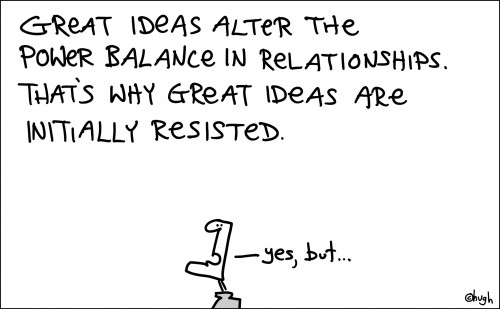I recall a story early in my career about the intern who saved the 1988 movie Gorilla’s in the Mist (I haven’t been unable to confirm its truth, but still a good story.) The story goes something like this. Gorilla’s in The Mist starring Sigourney Weaver as Diana Fossey a famous Mnt Gorilla expert living in the jungle studying the gorillas was hugely over budget. The studio was about to cancel it. The problem was they couldn’t get the gorillas to act in a way that fit the story line. Only allowed to shoot for an hour a day, days would be lost if the gorillas didn’t behave accordingly. To solve the problem and save the film, the producers, cast and director got together to determine what could be done. Ideas come in from using electronic gorillas to men in costumes. While the ideas were flowing back in forth a sole intern continually attempted to interject her idea. Continually over talked no one noticed her or paid attention. After several hours and little progress, she spoke up again. Exacerbated with little progress the group turned and asked her what her idea was. She mildly spoke up and asked a simple question. “Why can’t we scrap the story line, shoot as much footage as we can and then build the story around the footage?” Gorilla’s in the Mist saved.
I like this story because it illustrates the fact that good ideas sit everywhere in an organization. There should be no weighting of ideas based on title. Yet, many companies fall victim of this. Ideas are given priority based on title, operating from the assumption that best ideas come from the most senior people. Is your organization guilty of this?
It’s not enough to say your not. It’s not enough to say you value everyone’s opinions. Companies need to have the processes in place to actively seek out everyone’s ideas and opinions.
Companies who capture the knowledge of the entire organization develop ways to bring everyone to the table. Processes are put in place to engage employees at all levels. They are given a seat at the table and are encouraged to speak up. Hierarchies are broken down, formality is tossed aside and replaced with participation and expertise. “Sandboxes” are created to allow employees to test their ideas with out fear of failure. 3M has been known for creating one of the best environments for this. Enterprise 2.0 is also changing the landscape in this area.
I think Enterprise 2.0 is going to drastically change how organizations collaborate. This change is going to make it easier for companies to tap the “intern” and save the movie. Enterprise 2.0 doesn’t require permission to speak. It doesn’t require an invitation to the meeting. It doesn’t require validation of title. Enterprise 2.0 and many of its collaboration tools dig deep into a companies knowledge base and extracts once locked information and puts it in play. Whether or not your company includes the “intern” or not, Enterprise 2.0 and the next generation of collaboration tools WILL and everyone will be the better for it.
Information, ideas, and knowledge are not strictly attached to the board room. They are everywhere in the organization. Like a mine, the key is to find the valuable stuff and make at as easy as possible to get it out. Start digging!


